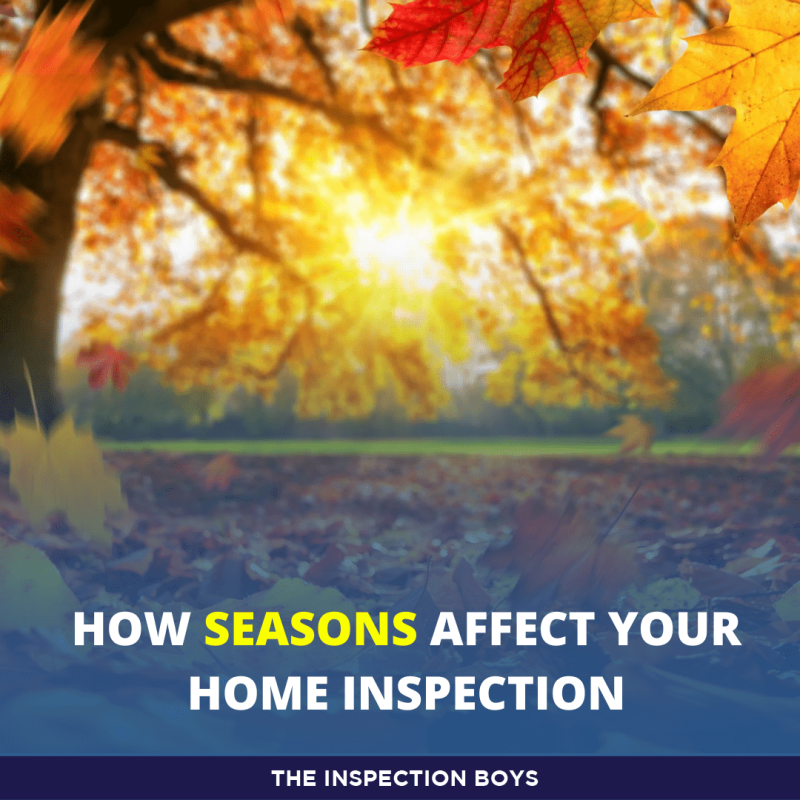A home inspection is one of the most important steps in buying or selling a home. But what many people don’t realize is that the time of year can significantly affect what an inspector can see, test, or even access. Whether it’s snow covering a roof, a dry spell hiding drainage issues, or sweltering heat masking HVAC problems, every season presents its own set of challenges and advantages.
Understanding how the seasons impact a home inspection can help buyers set realistic expectations, and it can help sellers prepare more effectively. Here’s what you should know before scheduling your inspection.
Winter: Hidden Roofs and Frozen Systems
Winter can be particularly tricky for home inspections. Snow and ice make it difficult or sometimes impossible for inspectors to examine the roof, gutters, and exterior drainage. A thick layer of snow might hide damage like missing shingles or flashing problems. Ice dams and frozen gutters can conceal water flow issues or even suggest leaks that aren’t typical year-round.
Another complication in colder climates is the HVAC system. Inspectors often can’t fully test air conditioning units during freezing temperatures. Trying to run the AC when it’s below 60 degrees can damage the compressor, so that part of the inspection might be deferred until warmer weather.
Also, outdoor plumbing features like sprinkler systems or exterior hose bibs are often shut off and winterized. This limits the inspector’s ability to test for leaks or proper operation.
Spring: Water Woes and Structural Surprises
Spring is often considered a good time for inspections, but it brings its own challenges, particularly related to moisture. As the ground thaws and seasonal rains begin, drainage and grading issues tend to become more visible. That can be a benefit for detecting water intrusion in basements or crawl spaces, but it also means the home might look worse than it would in a drier season.
Inspectors can also spot signs of roof or siding damage that occurred during winter, like ice dam residue or wind-related problems. On the flip side, spring foliage can sometimes obscure parts of the home, especially the roofline or foundation, which might limit visibility during the inspection.
Additionally, pests like termites and carpenter ants become more active in the spring, making it easier for inspectors to detect early infestations if they’re looking closely.
Summer: HVAC Under Pressure
In summer, inspectors can thoroughly test air conditioning systems under realistic conditions. This is valuable because issues like weak airflow, improper cooling, or strange noises are more noticeable when the unit is under stress. However, extreme heat can also cause certain systems to operate outside their normal range, which might skew some readings.
With dry ground, signs of water intrusion might be less obvious. A dry basement or crawl space in August doesn’t necessarily mean it stays dry year-round. This is where a good inspector’s attention to staining, efflorescence, or previous patchwork can be crucial.
On the plus side, roofs, gutters, siding, and windows are typically fully visible and accessible in summer. Inspectors can walk the roof if it’s safe, and they can check exterior features thoroughly without weather-related obstructions.
Fall: A Mixed Bag of Opportunity
Fall is often seen as a balanced season for inspections. The weather is moderate, which allows for thorough testing of both heating and cooling systems. It is also a time when inspectors can evaluate how the home is preparing for winter. Are the gutters clear? Is the attic properly insulated? Is there any sign of animal entry points as creatures look for warm shelter?
One potential downside is falling leaves. Piles of leaves can obscure walkways, yard drainage, or even roof valleys. And as temperatures begin to drop, exterior faucets and irrigation systems may already be winterized, limiting inspection access.
Still, fall offers a good window to catch problems before they’re covered up by snow or made worse by freezing temperatures.
When Seasonality Affects the Report
Home inspection reports often include notes like “not inspected due to seasonal conditions” or “limited visibility due to snow.” These disclaimers are standard, but it’s important to understand what they mean. If a major component couldn’t be inspected, like the roof or AC system, you may want to negotiate a follow-up inspection or repair allowance.
Buyers should also keep in mind that an inspection is a snapshot in time. Just because a basement was dry in July doesn’t mean it’s watertight in spring. Ask your inspector what seasonal issues might not be visible right now but could arise later. A good inspector will offer insight based on signs of past problems or typical regional concerns.
Should You Delay an Inspection Based on Season?
Generally, no. If you’re under contract, you don’t usually have the luxury of waiting for the perfect season. But if you’re preparing to list your home or starting a home search without a timeline, it’s worth considering when an inspection will be most informative.
Sellers, for instance, might want to schedule a pre-listing inspection in late spring or early summer, when most parts of the home are accessible and visible. Buyers might benefit from asking about historical concerns tied to the season, like whether a crawl space tends to flood in spring or if a fireplace gets regular use in winter.

